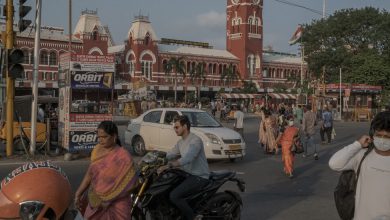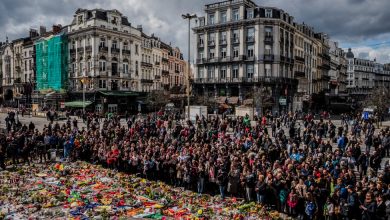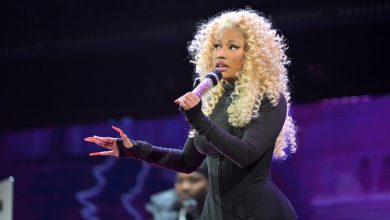Ron Galella, Celebrity-Hounding Photographer, Dies at 91

Ron Galella, the freelance photographer who relentlessly pursued Jacqueline Kennedy Onassis until a judge barred him from taking her picture, who pestered Marlon Brando until Brando broke his jaw, and who for better or worse helped define today’s boundary-challenged culture of celebrity, died on Saturday at his home in Montville, N.J. He was 91.
The cause was congestive heart failure, said Geoffrey Croft, a family spokesman who edited Mr. Galella’s most recent book, “100 Iconic Photographs — A Retrospective.”
Mr. Galella was called a creep, a stalker and worse when he began shooting pictures of celebrities in the 1960s, before mass circulation magazines like People and Us made the presence of paparazzi like him ubiquitous — and a full generation before phone cameras and websites like TMZ made celebrity stalking the pastime of legions.
For photographing superstars in the late ’60s without permission, a judge called Mr. Galella the most flagrant of the “two-bit chiselers and fixers” who sold such pictures for money. Starlets spit at him. Security men throttled him.
But the thick-skinned Mr. Galella lived to see his work widely esteemed: displayed in trendy galleries, compared to the photography of Diane Arbus and Henri Cartier-Bresson, and purchased by collectors and museums as exemplars of stargazer art. The Museum of Modern Art owns as many as five Galellas.
His pictures, most in black and white, came to be admired for their composition, insight and energy, which sometimes mimicked the kinetics of combat photography. In a 2010 article in T, the New York Times magazine, Mr. Galella’s signature style of close-up action photography was described as “intimate and aggressive at the same time.”
Bribing doormen, limo drivers and maids in order to position himself where no one expected him to be, Mr. Galella would often spring on his prey from hiding places in shrubbery or idling parked cars — not to frighten, he maintained, but to capture something beyond the carapace of their celebrity.
“Expressions on the human face are much more infinite when the person is caught unawares,” he said. He never used a viewfinder — the better to make eye contact. “You are looking at them person to person,” he explained. “That is greater than the subject looking at the camera, which is a machine.”
Whether his means justified his ends was another question, raised loudly and often by many of his subjects, most prominently the former first lady.
Mrs. Onassis waged a running court battle with him throughout the 1970s and early ’80s, testifying in one court hearing that he had made her life “intolerable, almost unlivable, with his constant surveillance.” Mr. Galella in turn claimed the right to earn a living by taking pictures of famous people in public places.
In 1972, a judge ordered him to keep 25 feet away from Mrs. Onassis and 30 feet away from her children. A decade later, facing jail time for violating the order — hundreds of times — Mr. Galella agreed never to take another picture of them. And he never did.
But he had plenty more to show — a pantheon of the era’s movie stars, jet-setters and royalty, from Brando and Elvis to the Duke and Duchess of Windsor. There was Robert Redford skulking down the street in business attire and sunglasses, betrayed by his five-alarm handsomeness. A puffy, worn Elvis amid a phalanx of fit-looking hangers-on. Barbra Streisand glaring into the camera with magisterial disdain. Woody Allen shielding himself with a hand, his eyes hinting at the real anxiety behind the anxiety shtick.
Publications like Time, Life, People and The National Enquirer were steady customers of his work.
At their best, his pictures suggested what Diane Arbus’s subjects might have photographed if they were paparazzi: stardom through the lens of the ultra-outsider.
At their most intrusive — like the early-1970s picture of Mrs. Onassis running down a grassy hill in Central Park fleeing the pursuing Mr. Galella — they suggested the dark side of Americans’ love-hate relationship with fame.
Reviewing “Smash His Camera,” a 2010 documentary about Mr. Galella, the critic Roger Ebert articulated the ambivalence many felt toward him, whether or not they knew the name of the photographer behind the memorable pictures he took. “I disapproved of him,” Mr. Ebert said, “and enjoyed his work.”
Ronald Edward Galella was born on Jan. 10, 1931, one of five children of Vincenzo and Michelina (Marinaccio) Galella, and grew up in the Bronx. His father made pianos and coffins; his mother was a crochet beader.
After serving as a photographer in the Air Force during the Korean War, Mr. Galella studied photography at the Art Center College of Design in Pasadena, Calif., and acting and stage direction at the Pasadena Playhouse — lessons he later credited with giving the best of his photographs their dramatic effect.
He married Betty Lou Burke in 1979, and she became his business partner. She died in 2017.Mr. Galella is survived by his brother Vincent and many nieces and nephews as well as great-nieces and -nephews.
His relentless pursuit of celebrities made him something of one himself. Mr. Galella put out 22 books in all, some devoted entirely to a single subject, like Donald J. Trump, Michael Jackson and, of course, Mrs. Onassis, and the gallery exhibitions that often accompanied them — each a publicity-generating photographic cavalcade of the famous — would put him at center stage.
Mr. Galella conceded that his motivation as a photographer was primarily mercenary, with artistic and neurotic motives thrown in for good measure. He stalked Mrs. Onassis because there was a lucrative market for pictures of her that no other photographer was tapping, he said in a 1983 interview. And because he was obsessed.
“Why did I have an obsession with Jackie? I’ve analyzed it,” he said in “Smash His Camera.” “I had no girlfriend. She was my girlfriend, in a way.”
Mr. Galella’s penchant for excess met its match, in a way, on June 12, 1973. The reclusive Marlon Brando was walking toward dinner in Manhattan’s Chinatown with a friend when, having been pursued by Mr. Galella all day, he finally beckoned him.
“What else do you want that you don’t already have?” an exasperated Brando asked, by Mr. Galella’s account. Mr. Galella replied, “I’d like a picture without the sunglasses.”
Brando declined, but Mr. Galella persisted, explaining that celebrities’ eyes were “what editors want to see.” With that, Brando reared back and punched him — sucker-punched him, in Mr. Galella’s telling — breaking his jaw and knocking out five teeth.
Mr. Galella said he later received $40,000 from Brando in settlement of a damages suit.
Yet some of the celebrities he pursued were also among Mr. Galella’s admirers. In a foreword to a 2002 collection of his work, Diane Keaton described him as the best chronicler of the fleeting beauty of the beautiful people of his time, the one who best captured the magnetism of those contemporaries, “who with a frowning or smiling turn of the head once had the power to crush or lift me.” Marlon Brando especially.
“In Galella’s photographs,” Ms. Keaton wrote, “Marlon Brando is still the most beautiful man I’ve ever seen.”





